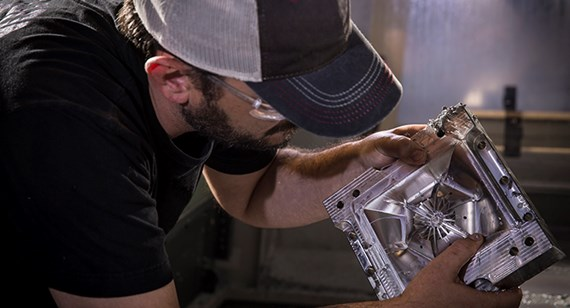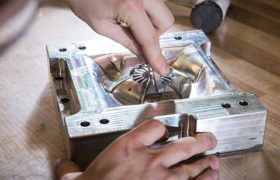In the traditional approach to product development, there is a sharp line between development and production. Development begins with a light bulb over someone’s head, proceeds through napkin sketches and CAD models, and ends, ultimately, with prototypes. At one or more points in the development process there may be input from the market, be it someone’s best guesses, one or more focus groups, or actual market tests. And from start to finish there is always pressure to “get on with it,” either because you need to catch up with a market leader or because you are the leader and someone may be catching up with you. But then, when you have reached your goal—a fully developed, marketable product—everything comes to a screeching halt and the drawings and/or models disappear into the “production machine,” from which, weeks or months later, a whole lot of deliverable product appears and the rush begins again as it heads off to market.

In plastic molding, as in most other technologies, some aspects of this transition are unavoidable. Production molds are costly, and they take time to manufacture. It would be risky to begin producing them before the design had been fully proven in development, when even a small change could turn tens of thousands of dollars’ worth of molds into doorstops and boat anchors.
Traditionally this has always presented manufacturers with a dilemma. They could keep development and manufacturing sequential and live with the resulting delay. Or they could treat them in parallel, starting on production molds before the end of development, cutting their time to market but running the risk of having to go back and start tool-making over again. It was a painful choice, because today’s competitive global markets reward both speed and low cost. Manufacturers already recognize that rapid injection molding as a prototyping method can reduce both cost and delay in the design of plastic parts. They are now beginning to see that it can also help reduce the post-development delay in bringing a product to market.
Bridge Tooling

While rapid injection molding is not identical to traditional production tooling, it is similar enough in process and technology to solve several problems and help speed up production. First, in addition to proving the design itself, it confirms that a part can actually be molded. Second, while production-tool molding can incorporate capabilities that rapid injection molding can’t—internal cooling lines or sophisticated venting, for example—adapting a part to the demands of rapid injection molding by equalizing wall thicknesses and maintaining draft can actually simplify and speed up the manufacture of production molds while reducing their cost. In other words, rapid injection molding doesn’t just produce prototype parts; it prototypes the production method that will produce those parts, allowing avoidable problems to be eliminated before the start of final mold making.
Perhaps even more important in today’s fast-moving markets, tools made for rapid injection molding can also be used to mold parts in actual production resins and in production volumes—thousand or even tens of thousands of parts—while the “official” production tools are being made. In other words, yesterday’s prototyping molds can produce today’s “go-to-market” parts while tomorrow’s ultra-high-volume molds are being made.
On-Demand Production
In fact, once it becomes clear that you can take “prototype” parts to market, you may actually find reasons to simply postpone the production of steel tools. One reason might be the ability to reduce up-front expenditures by ordering parts in smaller quantities than you commit to when you turn to production molds. This makes particular sense if there is any uncertainty about market demand for your new product. It’s a way of going beyond mere market tests and actually releasing your product to the market and gauging response before committing to full-scale production. If the market’s reaction to your product suggests the need for “tweaking,” you can make changes quickly and be back on the market in days with an improved product.
If necessary you can repeat the process several times, each at modest cost, before committing to mass production. In a sense, this sort of bridge tooling lets you treat a physical product in much the same way that software developers treat theirs, with versions tumbling onto the market one behind another as features are added.
There’s really no reason that releases of Widget Mark I, Mark II and Mark III have to be years apart if the market really wants an improved product. For those used to traditional methods this may be a novel approach, but if it eliminates that painful wait while production tools are being made it may be worth a try. And if it saves you the cost of sending tens of thousands of parts along with costly molds to the landfill because the market wants something slightly different, so much the better.
